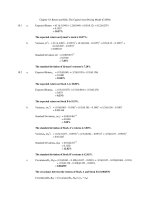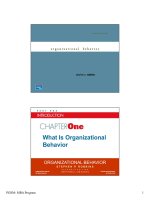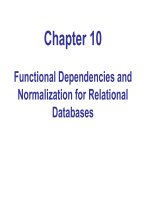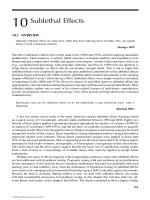Organizational behavior chapter 10 organization structrure
Bạn đang xem bản rút gọn của tài liệu. Xem và tải ngay bản đầy đủ của tài liệu tại đây (431.5 KB, 33 trang )
Chapter 10
ORGANIZATION STRUCTURE
For use with Organizational Behaviour and Management
by John Martin and Martin Fellenz
1408018128© 2010 Cengage Learning
Organization structure
• Organization structure - the formal
arrangement of task, communication and
authority relationships that influence and control
how people coordinate and conduct their work
For use with Organizational Behaviour and Management
by John Martin and Martin Fellenz
1408018128© 2010 Cengage Learning
The duality of structure
Figure 10.1
For use with Organizational Behaviour and Management
by John Martin and Martin Fellenz
1408018128© 2010 Cengage Learning
Organizational environments
Figure 10.2
For use with Organizational Behaviour and Management
by John Martin and Martin Fellenz
1408018128© 2010 Cengage Learning
Classic form of management
Table 10.1
For use with Organizational Behaviour and Management
by John Martin and Martin Fellenz
1408018128© 2010 Cengage Learning
Organization design
• Organization design - the process by which managers
select and manage aspects of an organization’s structure
and culture so that the organization can control the
activities necessary to achieve organizational goals
For use with Organizational Behaviour and Management
by John Martin and Martin Fellenz
1408018128© 2010 Cengage Learning
The challenges of organization design
Three categories:
• Appropriate horizontal and vertical division of labour
through differentiating the tasks that various
individuals and groups need to perform
• Structurally integrating the actors and their activities
and implementing mechanisms to enable
constructive coordination and control
• Determining the degree of centralization or
decentralization of decision making
For use with Organizational Behaviour and Management
by John Martin and Martin Fellenz
1408018128© 2010 Cengage Learning
Organization design
Guidance has traditionally taken one of three forms:
• Universalistic theories - scientific management and
other classical management approaches
• Contingency theories of organization - consider the
impact of environmental, situational, or organizational
factors
• Configurational theories - more complex than
contingency theories because they incorporate complex
arrangements and equifinality
For use with Organizational Behaviour and Management
by John Martin and Martin Fellenz
1408018128© 2010 Cengage Learning
Organizational height
Figure 10.3
For use with Organizational Behaviour and Management
by John Martin and Martin Fellenz
1408018128© 2010 Cengage Learning
Elements and principles of organizational
structure and structuring
• Horizontal differentiation
• Vertical differentiation
• Centralization and treatment of non-routine
decisions
• Communication, co-ordination and integration
• Formalization and standardization
• Job design
For use with Organizational Behaviour and Management
by John Martin and Martin Fellenz
1408018128© 2010 Cengage Learning
Functional organization
structure
Figure 10.4
For use with Organizational Behaviour and Management
by John Martin and Martin Fellenz
1408018128© 2010 Cengage Learning
Divisional organization structure
Figure 10.5
For use with Organizational Behaviour and Management
by John Martin and Martin Fellenz
1408018128© 2010 Cengage Learning
Process-oriented structure
Figure 10.6
For use with Organizational Behaviour and Management
by John Martin and Martin Fellenz
1408018128© 2010 Cengage Learning
Matrix structure
Figure 10.7
For use with Organizational Behaviour and Management
by John Martin and Martin Fellenz
1408018128© 2010 Cengage Learning
Project structure
Figure 10.8
For use with Organizational Behaviour and Management
by John Martin and Martin Fellenz
1408018128© 2010 Cengage Learning
Contingency model of organization
design
Figure 10.9
For use with Organizational Behaviour and Management
by John Martin and Martin Fellenz
1408018128© 2010 Cengage Learning
Multiple perspectives of an object
Figure 10.10
For use with Organizational Behaviour and Management
by John Martin and Martin Fellenz
1408018128© 2010 Cengage Learning
Weber and bureaucracy
Charismatic - authority is based around the personal qualities of the leader
Traditional - relies on accepted precedent as the dominant form of authority
Rational-legal - bureaucratic form of organization is termed rational because
of the (rational) objectives and legal because of its rule- and procedurebased approach to authority
Table 10.3
For use with Organizational Behaviour and Management
by John Martin and Martin Fellenz
1408018128© 2010 Cengage Learning
Gouldner and bureaucracy
:
Gouldner (1954) suggested three types of bureaucracy:
• Mock - The rules and procedures are largely ignored by all inside
having been imposed on them by an outside agency
• Punishment - a variant on the mock bureaucracy in that the rules
are imposed on the workers by management
• Representative - the rules and procedures are generally supported
by those inside the organization having been developed by
managers with the involvement of worker and stakeholder groups
For use with Organizational Behaviour and Management
by John Martin and Martin Fellenz
1408018128© 2010 Cengage Learning
Mechanistic and organic
organizations
Table 10.4
For use with Organizational Behaviour and Management
by John Martin and Martin Fellenz
1408018128© 2010 Cengage Learning
Reinforcing cycle for mechanistic
and organic configurations
Figure 10.11
For use with Organizational Behaviour and Management
by John Martin and Martin Fellenz
1408018128© 2010 Cengage Learning
Metaphors of organizations
Table 10.5
For use with Organizational Behaviour and Management
by John Martin and Martin Fellenz
1408018128© 2010 Cengage Learning
Mintzberg’s organizational parts
Figure 10.12
For use with Organizational Behaviour and Management
by John Martin and Martin Fellenz
1408018128© 2010 Cengage Learning
Mintzberg’s coordinating
mechanisms used in organizations
Table 10.6
For use with Organizational Behaviour and Management
by John Martin and Martin Fellenz
1408018128© 2010 Cengage Learning
Mintzberg’s coordinating
mechanisms
Figure 10.13
For use with Organizational Behaviour and Management
by John Martin and Martin Fellenz
1408018128© 2010 Cengage Learning









